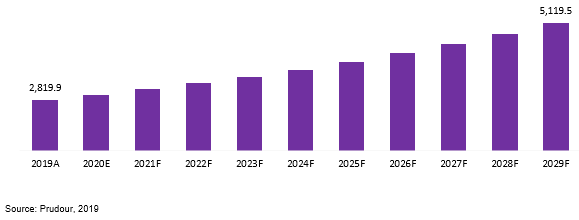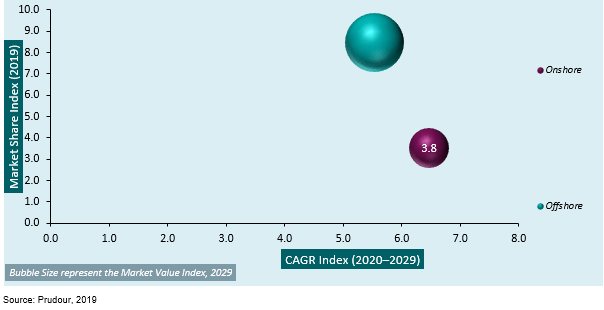Primary Cementing Equipment Market By Equipment Type (Floating Equipment, Casing Accessories, Cementing Plugs, And Other Equipment Types), By Application (Onshore, Offshore), By Region, and Key Companies - Industry Segment Outlook, Market Assessment, Competition Scenario, Trends and Forecast 2022-2032
- Published date: April 2023
- Report ID: 68627
- Number of Pages: 366
- Format:
- keyboard_arrow_up
Market.us announces the publication of its most recently generated research report titled, “Global primary cementing equipment market by Equipment Type (Floating Equipment, Casing Accessories, Cementing Plugs, External Casing Packers, Diversion Tools, Plug Containers, Stage Cementing Tools, and Other Equipment Types), By Application (Onshore, Offshore), and by Region – Global Forecast to 2029.”, which offers a holistic view of the global primary cementing equipment market through systematic segmentation that covers every aspect of the target market.
The Global Primary Cementing Equipment Market is projected to be US$ 2,819.9 Mn in 2022 to reach US$ 5,119.5 Mn by 2032 at a CAGR of 6.2%.
A casing is a pipe with a large diameter, inserted and assembled into a freshly drilled section of a borehole. The casing is placed inside the drilled borehole to support and protect the well stream, just like the bones of a spine protect the spinal cord. Cement held the lower portion of this casing in place. Not just cement is used to hold the casing in the position, but it also prevents fluid migration in between the subsurface formations. Typically cementing operations can be divided into two broad categories, those are: primary cementing and remedial cementing. The major purpose of primary cementing is to provide zonal isolation. Cementing operation is a process of mixing cement slurry, water, and cement additives, and pumping it down into the casing. Inside the open hole below the casing string and through all the critical points in the annulus around the casing. Primary cementing equipment includes items used during drilling in oil, gas, or water wells.
trending_up Total Revenue in 2018$ 2,819.9 Mn
trending_up Market CAGR of the Next Ten Years6.2%
no_encryption Market Value (US$ Mn), Share (%) and Growth Rate (%) Comparison 2012-2028Purchase this report or a membership to unlock the market value (US$ Mn), share (%) and growth rate (%) comparison for this industry.- By Type
- By Region
- By Application
no_encryption Leading Companies Financial HighlightsPurchase this report or a membership to unlock the leading companies financial highlights for this industry.trending_up Market Revenue of the Next Ten Years$ 5,119.5 Mn
The global primary cementing equipment market is anticipated to register stable growth over the forecast period, particularly in economies such as North America, owing to favorable growth factors present in these regions. Growing demand for energy worldwide urges the E&P companies to increase their investments in offshore and onshore oil & gas reserves. Increasing E&P companies for recovering unconventional (hydrocarbons) energy sources will augment the primary cementing operations, which will certainly drive the demand for primary cementing equipment hence driving target market growth. Amongst the well cementing, primary cementing is dominating the market. As primary cementing provides zonal isolation that prevents the migration of fluids in the annulus, it supports the casing and protects the casing strings from corrosive fluids. Growing applications of primary cementing in several end-use industries are further driving the growth of the global primary cementing equipment market.
Global Primary Cementing Equipment Market Revenue (US$ Mn), 2019–2029

Growing demand for energy worldwide urges the E&P companies to increase their investments in offshore and onshore oil & gas reserves. Expanding E&P companies for recovering unconventional (hydrocarbon) energy sources will augment the primary cementing operations which will certainly drive the demand for primary cementing equipment hence driving target market growth. Hydrocarbon production has gained traction, as it increased the reputation of being an additional source of energy. The growing number of cementing operations for hydrocarbon resources is certainly augmenting demand for primary cementing equipment which is expected to drive the market over the forecasted timeframe
Global Primary Cementing Equipment Market Attractiveness Analysis by Application, 2013–2019

Furthermore, E&P companies are increasing expenditures for improving sub-sea construction activities is augmenting the market for primary cementing equipment. Also, the continuously increasing area for offshore oil & gas blocks is augmenting offshore drilling activities, which are increasing demand for primary cementing; hence, driving the growth of the target market. Ever-increasing proper operations in onshore fields, particularly in countries such as the US, Saudi Arabia, Russia, and China, coupled with growing demand for Oil and Gas is driving the market. Amongst the segment based on type, floating equipment holds a significant market share, followed by casing accessories. Based on application, the market is segmented in Offshore and Onshore applications out of which offshore applications are anticipated to hold a significant market share. The growth of the offshore segment is owing to the cost decrease and digitalization of the oil & gas offshore projects.
The research report on the Global Primary Cementing Equipment Market includes profiles of some of the major companies such as Schlumberger Limited, Halliburton Company, Forum Energy Technologies, BJ Services, ACC Corporate, Bottle Oil Tools India Private Limited, Rubicon Oilfield International Holdings, L.P, Seenopex, VULCAN Completion Products, and Tangent Oil & Gas Equipment and Supply.
Key Market Segments
Type
- Floating Equipment
- Casing Accessories
- Cementing Plugs And Other Equipment Types
Application
- Offshore
- Onshore
Key Market Players included in the report:
- Schlumberger Limited
- Halliburton Company
- Forum Energy Technologies
- BJ Services
- ACC Corporate
- Botil Oil Tools India Private Limited
- Rubicon Oilfield International Holdings
- L.P
- Seenopex
- VULCAN Completion Products
- Tangent Oil & Gas Equipment and Supply
For the Primary Cementing Equipment Market research study, the following years have been considered to estimate the market size:
Attribute Report Details Market Size in 2022
US$ 2,819.9 Mn
Growth Rate
6.2%
Forecast Value in 2032
US$ 5,119.5 Mn
Historical Years
2016-2020
Base Year
2021
Estimated Year
2022
Short Term Projection Year
2028
Projected Year
2023
Long Term Projection Year
2032
Report Coverage
Competitive Landscape, Revenue analysis, Company Share Analysis, Manufacturers Analysis, Volume by Manufacturers, Key Segments, Key company analysis, Market Trends, Distribution Channel, Market Dynamics, COVID-19 Impact Analysis, strategy for existing players to grab maximum market share, and more.
Regional Scope
North America, Europe, Asia-Pacific, South America, Middle East & Africa
Country Scope
United States, Canada and Mexico, Germany, France, UK, Russia and Italy, China, Japan, Korea, India and Southeast Asia, Brazil, Argentina, Colombia etc.Saudi Arabia, UAE, Egypt, Nigeria and South Africa
 Primary Cementing Equipment MarketPublished date: April 2023add_shopping_cartBuy Now get_appDownload Sample
Primary Cementing Equipment MarketPublished date: April 2023add_shopping_cartBuy Now get_appDownload Sample - Schlumberger Limited
- Halliburton Company
- Forum Energy Technologies
- BJ Services
- ACC Corporate
- Botil Oil Tools India Private Limited
- Rubicon Oilfield International Holdings
- L.P
- Seenopex
- VULCAN Completion Products
- Tangent Oil & Gas Equipment and Supply
- settingsSettings
Our Clients
| Single User $4,599 $3,499 USD / per unit save 24% | Multi User $5,999 $4,299 USD / per unit save 28% | Corporate User $7,299 $4,999 USD / per unit save 32% | |
|---|---|---|---|
| e-Access | |||
| Report Library Access | |||
| Data Set (Excel) | |||
| Company Profile Library Access | |||
| Interactive Dashboard | |||
| Free Custumization | No | up to 10 hrs work | up to 30 hrs work |
| Accessibility | 1 User | 2-5 User | Unlimited |
| Analyst Support | up to 20 hrs | up to 40 hrs | up to 50 hrs |
| Benefit | Up to 20% off on next purchase | Up to 25% off on next purchase | Up to 30% off on next purchase |
| Buy Now ($ 3,499) | Buy Now ($ 4,299) | Buy Now ($ 4,999) |










